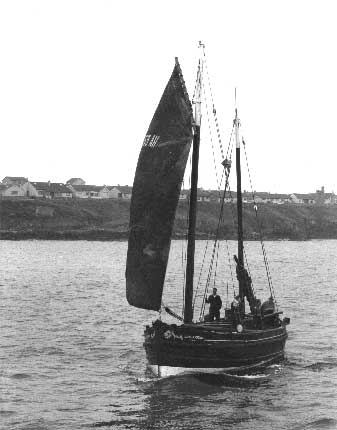|
Isabella Fortuna
All Fifies have near vertical stems and sternposts in contrast to the raked sternposts of the Scaffies (which came before) and the Zulus, starting in 1879 and named after the Zulu wars, which were built in competition with the Fifies. Herring were caught using drift nets. All types of craft were fitted with a dipping lug sail on the main (front) mast and a standing lug on the mizzen mast, and in fine weather would set a jib sail, sometimes on a bowsprit. Lug sails hang from a spar with most of the spar and sail aft of the mast, and the base of the sail is loose footed so needs no boom. When the craft tacks the sail would blow on to the mast so must be "dipped", part lowered, to work the sail around the mast and fill properly. From 1900 to 1920 most new boats were large and steam driven but as herring diminished they were replaced by versatile new motor "Fifies", without sails, which fished alongside converted craft like the Isabella Fortuna, often using the new sein-net. Later, many boats were fitted with small auxiliary engines for use when the wind dropped. The Isabella got one in 1919 and, in 1928, abandoned sails and fitted the 44 HP Kevin K2 diesel which she still has. |
 The Wick Heritage Society is to be congratulated on the latest venture, a 44 foot long Fifie built in
Arbroath in 1890, restored in Wick lifeboat shed in 1998.
The Wick Heritage Society is to be congratulated on the latest venture, a 44 foot long Fifie built in
Arbroath in 1890, restored in Wick lifeboat shed in 1998.